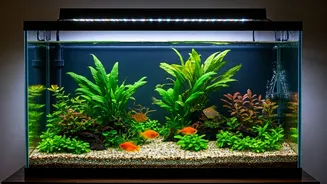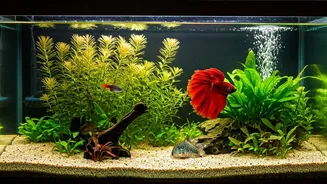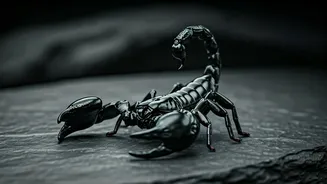The Beginner's Aquarium
Setting up an aquarium can seem daunting, but it doesn't have to be. For beginners, starting small is often the best approach. A 10-gallon tank is a manageable
size to begin with. The first step involves selecting the right equipment: a filter to keep the water clean, a heater to maintain a consistent temperature, and a light to illuminate the tank. Before introducing fish, the tank must undergo a cycling process, which establishes a healthy bacterial balance essential for breaking down fish waste. This process typically takes several weeks. Once the tank is cycled, consider adding plants and decorations to create a natural habitat for your fish. Ensure all equipment is designed specifically for aquarium use to maintain a safe and suitable environment for your aquatic pets. Regular water changes, typically 25% weekly, are essential for maintaining water quality and the health of your fish.
Guppy's Delightful Colors
Guppies are often considered the ideal choice for novice aquarists due to their hardiness and vibrant appearance. These small, live-bearing fish come in a dazzling array of colors and patterns, making them visually appealing additions to any tank. Guppies are adaptable and can thrive in various water conditions, provided the water is clean and well-oxygenated. They are relatively easy to feed, accepting flakes, pellets, and occasional live or frozen foods. A balanced diet contributes to their overall health and color intensity. Guppies are prolific breeders, so it's essential to manage their population if you have both males and females. A well-planted tank can provide hiding spots for the fry. To prevent overcrowding, consider separating the males and females, or providing adequate space for breeding and fry survival.
Betta: The Siamese Fighter
Betta fish, also known as Siamese fighting fish, are striking in appearance and relatively easy to care for, making them a popular choice. Males are particularly known for their elaborate fins and vibrant colors. It's crucial to keep male bettas separated, as they will fight. A single male betta can be kept in a 5-gallon tank, but ensure it is well-filtered and heated. Betta fish are labyrinth fish, which means they can breathe atmospheric oxygen, but still require clean water. They prefer slightly acidic water and a stable temperature. Their diet consists of betta-specific pellets or flakes, supplemented with occasional treats like bloodworms or brine shrimp. Provide a variety of hiding places, such as plants or decorations, to reduce stress and enhance their well-being. Regular water changes and a clean environment are critical for their health and longevity.
Neon Tetra's Shimmer
Neon tetras bring a splash of color to any aquarium with their bright neon blue stripe and red tail. They are peaceful, schooling fish that are best kept in groups of six or more. This schooling behavior provides comfort and enhances their visual appeal. Neon tetras are relatively hardy and adaptable to various water parameters, though they prefer slightly acidic water. A well-planted tank with subdued lighting mimics their natural habitat and reduces stress. Feed them small flakes or pellets designed for tropical fish, supplementing with occasional live or frozen foods. Maintain consistent water quality through regular partial water changes. Monitor the tank for any signs of disease and address them promptly. Due to their small size, they are ideal for community tanks with other peaceful fish.
Corydoras: The Cleaners
Corydoras catfish are excellent additions to any community aquarium as they help to keep the substrate clean. They are bottom-dwellers, and their active foraging habits help consume uneaten food and detritus, maintaining a healthy tank environment. Corydoras come in a variety of species, each with unique patterns and colors. They are peaceful and enjoy the company of their own kind, so keeping them in groups of at least three is advisable. These fish prefer a soft, sandy substrate to protect their barbels and are relatively easy to feed, accepting sinking pellets and wafers. A well-maintained tank with clean water and suitable hiding places is crucial for their well-being. Regular water changes and a stable environment help in their longevity. Choose a species that is appropriate for the tank size and other tank inhabitants.






